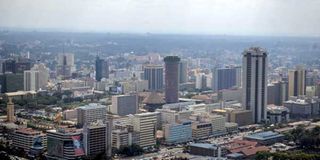Air pollution reduces effectiveness of antibiotics

Kenya’s transport sector, United Nations Environment Programme says, is a major contributor to air pollution, especially in Nairobi, due to a rapidly growing number of second-hand vehicles and poor road infrastructure that leads to traffic congestion and air pollution. PHOTO | FILE
What you need to know:
- In particular, the pollutant affects the survival of bacteria in the lining of the respiratory tract, changing “how well they are able to hide from, and combat, our immune systems”, the study reveals.
- The black carbon also caused Streptococcus pneumoniae to spread from the nose to the lower respiratory tract, which occasioned subsequent infection.
- Kenya’s transport sector, United Nations Environment Programme says, is a major contributor to air pollution, especially in Nairobi, due to a rapidly growing number of second-hand vehicles and poor road infrastructure that leads to traffic congestion and air pollution.
Air pollution, a new study shows, can alter the effectiveness of antibiotics and increase the risk of contracting bacterial diseases.
Specifically, bacteria that cause respiratory infections are directly affected by air pollution, which increases the possibility of infections and hampers the effectiveness of antibiotic treatment.
Pollutants such as black carbon, a major air pollutant produced through the burning of fossil fuels such as diesel, biofuels, and biomass (wood, organic waste), change the way in which bacteria grow and form communities.
The research focused on two human pathogens, Staphylococcus aureus and Streptococcus pneumoniae, both of which cause respiratory diseases such as skin and soft tissue infections like boils, bloodstream infections, pneumonia, and bone and joint infections. Both bacteria exhibit high levels of resistance to antibiotics.
In particular, the pollutant affects the survival of bacteria in the lining of the respiratory tract, changing “how well they are able to hide from, and combat, our immune systems”, the study reveals.
POLLUTED CITY
The team of researchers found that black carbon alters the antibiotic tolerance of Staphylococcus aureus and increases the resistance of communities of Streptococcus pneumoniae to penicillin, the key treatment of bacterial pneumonia.
The black carbon also caused Streptococcus pneumoniae to spread from the nose to the lower respiratory tract, which occasioned subsequent infection.
Dr Julie Morrissey, Associate Professor in Microbial Genetics in the University of Leicester’s Department of Genetics said: “This work increases our understanding of how air pollution affects human health.”
The lead author of the paper added: “Our research could initiate an entirely new understanding of how air pollution affects human health. It will lead to enhancement of research to understand how air pollution leads to severe respiratory problems and perturbs the environmental cycles essential for life.”
These findings come at a time when people worldwide are exposed to air pollution every time they take in a lungful of air due to rapid urbanisation. Already, about seven million people die prematurely each year from air pollution related infections. Of this, nearly a million are from Africa.
Kenya’s transport sector, United Nations Environment Programme says, is a major contributor to air pollution, especially in Nairobi, due to a rapidly growing number of second-hand vehicles and poor road infrastructure that leads to traffic congestion and air pollution.
Babies born to mothers exposed to air pollution from traffic during pregnancy have an increased risk of developing asthma during their first five years, another study shows. It is worse in children born with a low birth weight as they are “more inclined to the respiratory effects of air pollution.”
Because of these risks, the World Health Organisation has termed air pollution as the “largest single environmental health risk”.
The four-year research at the University of Leicester analysed the impact of black carbon on bacteria in the nose, throat and lungs.
It was published in the journal Environmental Microbiology.
******
THE RISKS
Air pollution is contamination of the indoor or outdoor environment by any chemical, physical or biological agent that modifies the natural characteristics of the atmosphere.
Household combustion devices, motor vehicles, industrial facilities and forest fires are common sources of air pollution.
According to the Global Alliance on Health and Pollution, health consequences of air pollution alone cost low- and middle-income countries six to 12 per cent of their Gross Domestic Product every year.
Nairobi diaries
A 2001 analysis of air pollution in Nairobi by two University of Nairobi researchers showed that suspended particles in the air are above World Health Organisation recommended pollutant concentration levels in most parts of the city.
The amount of cancer-causing elements in the air within the city is as high as 105 microgrammes per cubic metre, 10 times more than the World Health Organisation’s (WHO) threshold of 20 microgrammes per cubic metre for key air pollutants.



